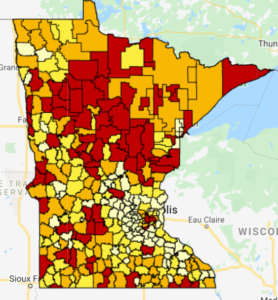MREA Releases ESSER Funds Map and Answers ESSER Questions
The federal government recently announced the official allocations of the ESSER III funds. MREA’s map shows the allocation of the ESSER I, II and III federal dollars, per pupil, based on each district’s 2020 average daily membership. The funds shown in the map account for the 90 percent of funding that was allocated directly to districts. The remaining 10 percent of the ESSER funds will be used at the state’s discretion.
VIEW MREA ESSER Funds Distribution Map
With much information circling around what ESSER funds are based on and what they can be used for, MREA answers some of the ESSER questions we most often receive from members.
How are ESSER funds allocated?
ESSER dollars were based, in part, on Title I, Part A allocations (and now ESSER I, ESSER II, and ESSER III allocations) that use traditional geographic school district population poverty estimates from the U.S. Census Bureau. In addition, the funds are determined based on a statistical model that incorporates information from:
- Census Bureau’s American Community Survey,
- Administrative records taken from Federal income tax returns,
- Supplemental Nutrition Assistance Program,
- The most recent decennial Census and recent updates to population estimates,
- Data on Supplemental Security Income recipients, and
- Economic data from the Bureau of Economic Analysis.
ESSER funds must be allocated according to the Federal Title I, Part A formula. MDE does not have authority to ignore or change the federal formula requirements for these federal funds.
Did metro districts receive more or less ESSER funding than rural districts?
While it’s true that Minneapolis and St. Paul ($7,598 per pupil and $9,267 per pupil, respectively) received amounts well above the median of $1,617 per pupil, there were also rural districts that received the same or greater amounts.
What can ESSER funds be used for?
Districts may use the funds for a wide range of activities to address needs arising from the Coronavirus pandemic, including any activity authorized by the Elementary and Secondary Education Act (ESEA), the Individuals with Disabilities Education Act (IDEA), Adult Education and Family Literacy Act (AEFLA) or Carl D. Perkins Career and Technical Education Act of 2006 (Perkins CTE).
Specifically, ESSER funds may be used to develop strategies and implement public health protocols including, to the greatest extent practicable, policies in-line with guidance from the Centers for Disease Control and Prevention (CDC) on re-opening and operating schools to effectively maintain the health and safety of students, educators and other staff, as well as:
- coordinating preparedness and response efforts with State, local, Tribal, and territorial public health departments to prevent, prepare for, and respond to COVID-19;
- training and professional development on sanitizing and minimizing the spread of infectious diseases;
- purchasing supplies to sanitize and clean the LEA’s facilities;
- repairing and improving school facilities to reduce risk of virus transmission and exposure to environmental health hazards; • improving indoor air quality;
- addressing the needs of children from low-income families, children with disabilities, English learners, racial and ethnic minorities, students experiencing homelessness, and foster care youth;
- developing and implementing procedures and systems to improve the preparedness and response efforts of LEAs;
- planning for or implementing activities during long-term closures, including providing meals to eligible students and providing technology for online learning;
- purchasing educational technology (including hardware, software, connectivity, assistive technology, and adaptive equipment) for students that aids in regular and substantive educational interaction between students and their classroom instructors, including students from low-income families and children with disabilities;
- providing mental health services and supports, including through the implementation of evidencebased full-service community schools and the hiring of counselors;
- planning and implementing activities related to summer learning and supplemental after-school programs;
- addressing learning loss; and
- other activities that are necessary to maintain operation of and continuity of and services, including continuing to employ existing or hiring new LEA and school staff.
Can different rounds of ESSER funding be spent on similar things?
For the most part, districts can use ESSER I, II and III funds similarly. However, the ESSER III funds specify that districts need to use at least 20 percent of funds to address learning loss by implementing evidence-based interventions and ensuring those interventions respond to students’ social, emotional and academic needs. The funds must also address the disproportionate impact of COVID-19 on under-represented student sub-groups. Also, there is a maintenance of equity provision that needs to be adhered to.
Will districts that didn’t receive as much money receive any additional funding?
The proposed Senate omnibus bill includes funds to help districts that did not receive as much in ESSER payments. This is a push to encourage the state to use some of their discretionary ESSER money on districts that may not have received as much per pupil of ESSER funding.
How can I see the distribution of the three ESSER dollar distributions?
A comparison of the three ESSER dollar distributions can be found here.






